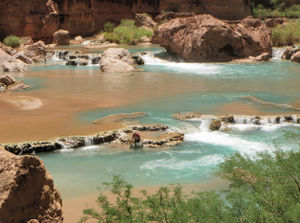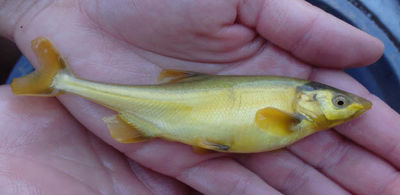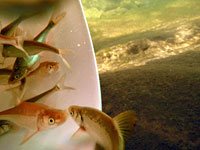|
|
| Line 88: |
Line 88: |
| | | | |
| | [[File:Havasu Creek lower barrier near confluence 2-Sorensen-2011.JPG|thumb|right|300px|Falls in Lower Havasu Creek]] <br> | | [[File:Havasu Creek lower barrier near confluence 2-Sorensen-2011.JPG|thumb|right|300px|Falls in Lower Havasu Creek]] <br> |
| − | [https://www.nps.gov/grca/learn/nature/shinumotransloc.htm Grand Canyon National Park translocations] [https://www.nps.gov/grca/learn/nature/fish-humpback-chub.htm (more information)]
| |
| | | | |
| | ===Objectives === | | ===Objectives === |
| | | | |
| − | ===Project History===
| |
| | | | |
| − | ===Results===
| |
| − |
| |
| − | ===Next Steps===
| |
| | | | |
| | | | |
| | | | |
| | + | ===Project History=== |
| | | | |
| | | | |
| Line 105: |
Line 101: |
| | | | |
| | | | |
| | + | ===Results=== |
| | | | |
| | | | |
| Line 110: |
Line 107: |
| | | | |
| | | | |
| | + | ===Next Steps=== |
| | | | |
| | | | |
| Line 120: |
Line 118: |
| | [[Image:ShinumoWaterfall.jpg|thumb|right|300px|Falls at the mouth of Shinumo Creek]] <br> | | [[Image:ShinumoWaterfall.jpg|thumb|right|300px|Falls at the mouth of Shinumo Creek]] <br> |
| | [[Image:AntennaInstal10.jpg|thumb|right|300px|PIT antenna install in Shinumo Creek]] <br> | | [[Image:AntennaInstal10.jpg|thumb|right|300px|PIT antenna install in Shinumo Creek]] <br> |
| − | Included as a Conservation measure in the 2008 and 2011 Biological Opinions <br> | + | [https://www.nps.gov/grca/learn/nature/shinumotransloc.htm Grand Canyon National Park translocations] [https://www.nps.gov/grca/learn/nature/fish-humpback-chub.htm (more information)] |
| | + | |
| | + | *Included as a Conservation measure in the 2008 and 2011 Biological Opinions <br> |
| | | | |
| | ===Objectives === | | ===Objectives === |
Projects
|
Chute Falls Translocation (Little Colorado River)
YouTube: Humpback Chub Translocation in the Little Colorado River
Background [1]
- Prior to translocations: no HBC above Chute Falls (fish barrier or high CO2 levels). Since 2003, six chub have been documented ascending Chute Falls on their own accord. [2]
- High productivity and higher winter water temperatures than the lower LCR should equal higher growth rates and faster maturity
- Translocations began 2003
- ~3,106 juvenile humpback chub have been translocated from the lower reaches of the LCR to upstream of Chute Falls (2015) [3]
- Annual Monitoring – hoop nets surveys in May or June
Objectives
2003-2005 [4]
- Determine if HBC can survive and remain above Chute Falls: yes, translocated fish had higher survival than Coggins et al. 2006 estimate. Good retention during most years but populations is susceptible to stochastic events (e.g. 2010 flood)
- Determine if HBC grow (given increased food availability, but potential detrimental impacts from CO2):
- By the 1st ensuing spring since being released 16% of age-1 translocated chub had achieved adult size (>200 mm TL).
- By the 2nd ensuing spring since being released 96% of age-2 chub had achieved adult size. [5]
- Determine if HBC can recruit to adulthood: yes
- Determine if HBC spawning population will develop: tbd
2006-Present [6]
- Conduct mark/recapture population estimates – 2 reaches (>CF and LA to CF) to determine:
- Migration patterns: Chute is not a complete barrier to chub moving upstream, movement throughout, including to the mainstem
- Growth rates: higher growth rates than fish lower in the LCR
- Spawning activity: ripe fish and YOY fish found above Chute in 2007
- Assess overall benefit to LCR HBC: Appears to be one of few tools available to directly increase adult population if needed in future.
Translocations are relatively easy and inexpensive beneficial conservation actions compared to other options that may be much more expensive and politically difficult to implement. [7]
Havasu Creek Translocations
 Falls in Lower Havasu Creek
Objectives
Project History
Results
Next Steps
Shinumo Creek Translocations [8]
 Falls at the mouth of Shinumo Creek
 PIT antenna install in Shinumo Creek
Grand Canyon National Park translocations (more information)
- Included as a Conservation measure in the 2008 and 2011 Biological Opinions
Objectives
- Primary: Develop second spawning population
- Provide rearing (grow-out) opportunities, augmentation of mainstem aggregations
Project History
Translocated 1,102 humpback chub (total):
- 2009: 302
- 2010: 300
- 2011: 300
- 2013: 200
June 2014 population estimate: ≈125 to 190 individuals (preliminary; all years represented)
Results
- Meeting Objectives for rearing/”grow-out”
- Annual growth greater than in the mainstem Colorado River but less than in the LCR 2 out of 3 years (2013-14 results pending)
- Large portion of mainstem captures at the mouth of Shinumo are translocated fish
- No reproduction (but fish were still young)
Galahad Point Fire – May-July 2014 [9]
Shinumo Creek flooding (containing ash) reported in July and August
- PIT tag antenna destroyed in July
- >99% decline in fish, overall
- High density of rainbow trout in Merlin Abyss Creek (½ mile of undamaged habitat)
- Bluehead sucker and humpback chub believed to be extirpated
- Significant channel alteration, pools filled
- 80-90% loss of riparian vegetation
Next Steps
- Remove remaining trout in Merlin Abyss
- Monitor habitat recovery
- In 3-5 years restore native fish community throughout watershed (humpback chub, speckled dace, bluehead sucker)
Bright Angel Creek Translocations (proposed; following NPS trout reduction)
Beaver Falls Translocations (Havasu Creek) (proposed; Conservation Measure)
Mainstem Translocations in Western Grand Canyon (proposed)
Mainstem Translocations at the LCR (proposed; Conservation Measure)
|
|
Links and Information
|
|
The Humpback Chub Page
|
Presentations and Papers
|
|
2017
2016
2015
2014
2013
2006
|
Other Stuff
|
|
|






